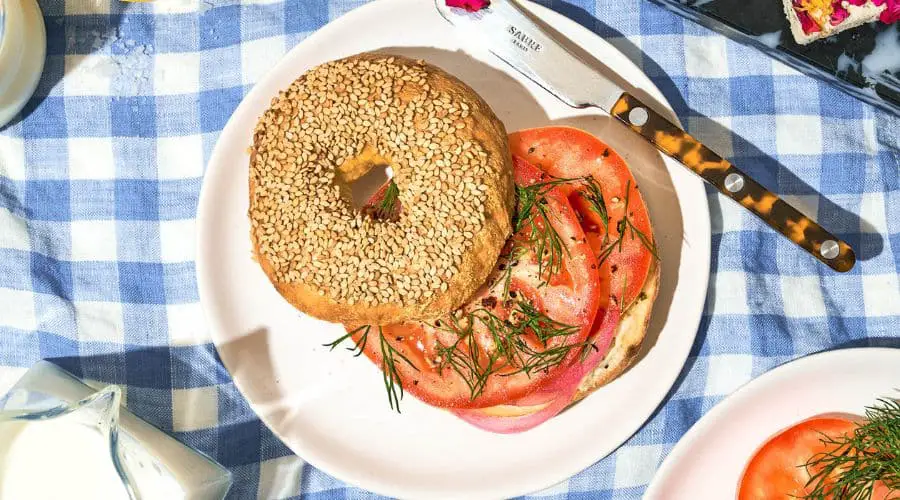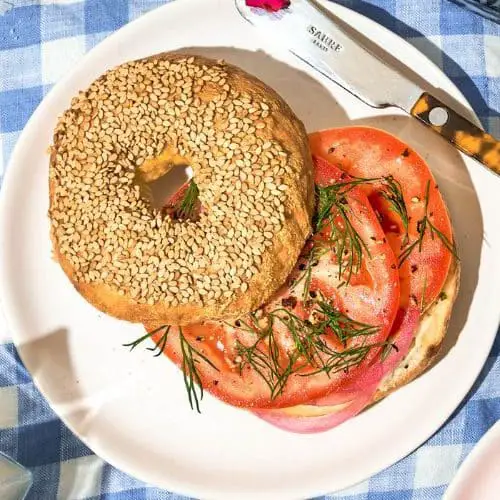All products are selected by our editorial team for quality. If you buy through our links, we may earn a small commission at no extra cost to you.
Vegan bagels are a delicious and versatile alternative to traditional bagels.
They have the same chewy texture and rich flavor but without any animal products.
Making bagels at home might seem intimidating, but it is easier than you think.
With just a few simple ingredients and a little patience, you can create bakery-quality bagels in your own kitchen.
This recipe is perfect for beginners and experienced bakers alike.
Whether you enjoy them plain, topped with seeds, or infused with flavors, these homemade vegan bagels will quickly become a staple in your kitchen.

Why Make Your Own Vegan Bagels?
Homemade bagels give you complete control over the ingredients.
Many store-bought bagels contain additives, preservatives, or non-vegan ingredients like honey and dairy.
When you make your own, you ensure that every bite is plant-based and free from unnecessary chemicals.
Baking at home is also more cost-effective.
A batch of homemade bagels costs a fraction of what you would pay at a bakery.
Plus, you can customize them to suit your taste.
From whole wheat to cinnamon raisin, you can experiment with different flavors and toppings.
There is also something deeply satisfying about making bagels from scratch.
The process of kneading, shaping, boiling, and baking gives you a greater appreciation for this classic bread.
Key Ingredients for Vegan Bagels
Flour
The type of flour you use affects the texture of your bagels.
Bread flour is ideal because it has a higher protein content, which helps create a chewy texture.
All-purpose flour works too, but it may result in a softer bagel.
For a denser, more nutritious option, whole wheat flour can be used, though it may require slight adjustments in hydration.
Yeast
Yeast is essential for the dough to rise and develop its signature airy texture.
Active dry yeast and instant yeast both work, but instant yeast does not need to be activated in warm water beforehand.
Sweetener
A touch of sweetness enhances the flavor of the bagels.
Instead of honey, use maple syrup, agave, or coconut sugar to keep the recipe fully vegan.
Water
Hydration is crucial for the dough’s consistency.
The amount of water you use determines how soft or firm your bagels will be.
Warm water also helps activate the yeast for a better rise.
Salt
Salt enhances the overall flavor and balances the sweetness.
It also strengthens the gluten structure, improving the bagel’s texture.
Boiling Solution
Before baking, bagels are briefly boiled to create a chewy crust.
A traditional boiling solution includes water with baking soda or barley malt syrup.
Baking soda helps develop a golden-brown color, while barley malt syrup adds a subtle sweetness and a more authentic bagel taste.
Optional Add-Ins
You can customize your bagels with different mix-ins and toppings.
Sesame seeds, poppy seeds, and everything bagel seasoning are classic choices.
For a sweeter variation, try adding cinnamon, raisins, or dried cranberries to the dough.
Step-by-Step Guide to Making Vegan Bagels

1. Preparing the Dough
In a large mixing bowl, combine the flour, yeast, salt, and sweetener.
Gradually add warm water and mix until a dough forms.
Knead the dough for about 10 minutes until it becomes smooth and elastic.
Place the dough in a greased bowl, cover it with a damp cloth, and let it rise for about an hour or until it doubles in size.
2. Shaping the Bagels
Once the dough has risen, punch it down to release excess air.
Divide it into equal portions and shape each piece into a ball.
There are two common ways to form bagels.
One method is rolling the dough into a rope, then connecting the ends to form a ring.
The other method is shaping a ball and poking a hole in the center with your finger, then gently stretching it to create an even circle.
Place the shaped bagels on a baking sheet and let them rest for about 15 minutes.
3. Boiling the Bagels
Bring a large pot of water to a gentle boil and add baking soda or barley malt syrup.
Carefully drop the bagels into the water, boiling them for 30 to 45 seconds on each side.
This step gives bagels their signature chewy texture and helps them develop a golden crust when baked.
Use a slotted spoon to remove the bagels and place them back on the baking sheet.
If adding toppings, sprinkle them on while the bagels are still wet.
4. Baking to Perfection
Preheat your oven to 425°F (220°C).
Place the boiled bagels on a lined baking sheet, spacing them apart to allow for even baking.
Bake for 20 to 25 minutes, flipping them halfway through to ensure even browning.
When the bagels turn golden brown and sound hollow when tapped, they are ready.
Let them cool slightly before slicing and serving.
Would you like me to continue with the next sections?
Flavor Variations and Toppings
Homemade vegan bagels can be customized with a variety of flavors and toppings.
Whether you prefer a classic, sweet, or savory bagel, there are endless possibilities to experiment with.
Classic Plain Bagels
A simple plain bagel is a timeless favorite.
Its neutral flavor pairs well with both sweet and savory spreads.
Enjoy it fresh out of the oven or toasted with your favorite toppings.
Everything Bagel
Everything bagel seasoning is a popular choice for those who love a bold, savory flavor.
It typically includes sesame seeds, poppy seeds, dried garlic, dried onion, and coarse salt.
To achieve this flavor, sprinkle the seasoning generously over the boiled bagels before baking.
Sesame or Poppy Seed Bagels
For a more subtle crunch, sesame seeds or poppy seeds make excellent toppings.
Lightly press the seeds onto the bagels after boiling to ensure they stick during baking.
Cinnamon Raisin Bagels
Cinnamon raisin bagels are perfect for those who enjoy a slightly sweet breakfast.
Add a teaspoon of ground cinnamon and a handful of raisins to the dough before kneading.
For extra sweetness, you can brush the baked bagels with a light maple syrup glaze.
Garlic and Herb Bagels
For a more savory twist, mix dried or fresh herbs like rosemary, thyme, or oregano into the dough.
You can also add minced garlic for an extra layer of flavor.
A sprinkle of coarse salt on top enhances the overall taste.
Sun-Dried Tomato and Basil Bagels
For a Mediterranean-inspired variation, finely chop sun-dried tomatoes and fresh basil leaves and mix them into the dough.
This combination pairs well with vegan cream cheese or hummus.
Chocolate Chip Bagels
Chocolate chip bagels are a delightful treat for those who enjoy a hint of sweetness.
Add dairy-free chocolate chips to the dough before shaping.
Serve them warm with a spread of vegan butter or nut butter.
Storage and Freezing Tips
Homemade bagels taste best when they are fresh, but proper storage can keep them delicious for days.
Storing Fresh Bagels
If you plan to eat the bagels within a few days, store them at room temperature.
Place them in a paper bag or wrap them in a clean kitchen towel to maintain their texture.
For longer freshness, keep them in an airtight container.
Avoid storing them in plastic bags at room temperature, as this can make them soggy.
Refrigerating Bagels
If you need to store bagels for more than two days, refrigeration can help keep them fresh.
Wrap each bagel individually in plastic wrap or place them in an airtight container.
Before eating, toast them to restore their crispy crust and chewy texture.
Freezing Bagels
Freezing is the best way to extend the shelf life of homemade bagels.
Slice the bagels in half before freezing to make reheating easier.
Wrap each bagel in plastic wrap and place them in a freezer-safe bag.
Label the bag with the date to keep track of freshness.
Frozen bagels can be stored for up to three months.
Reheating Frozen Bagels
To reheat a frozen bagel, place it directly in a toaster or toaster oven.
You can also bake it at 350°F (175°C) for about 10 minutes until warmed through.
If you prefer a softer texture, microwave the bagel for 30 seconds before toasting.
Would you like me to continue with the next sections?
Common Mistakes and Troubleshooting
Even with a simple recipe, making bagels can come with a few challenges.
Here are some common mistakes and how to fix them.
Dough Too Dry or Too Sticky
If the dough is too dry, it may be because there is not enough water.
Add small amounts of warm water, a teaspoon at a time, until the dough becomes soft and pliable.
If the dough is too sticky, it may have too much moisture or not enough flour.
Sprinkle in a little extra flour while kneading until it becomes manageable.
Bagels Not Rising Properly
Yeast needs warmth to activate.
If your dough is not rising, check that your yeast is fresh and active.
Make sure the water used to mix the dough is warm, but not too hot, as excessive heat can kill the yeast.
Let the dough rise in a warm, draft-free area.
If your kitchen is cold, place the bowl inside a slightly warmed oven with the door cracked open.
Over or Under-Boiling
Boiling bagels for too long can lead to a dense, tough texture.
Boiling for too short a time may result in a weak crust.
The ideal boiling time is 30 to 45 seconds per side.
Ensure the water is at a gentle boil, not a rolling one, to avoid overcooking.
Uneven Baking
Bagels that bake unevenly might be placed too close together on the baking sheet.
Make sure there is enough space between them for even airflow.
If bagels brown too quickly on the outside while remaining undercooked inside, lower the oven temperature slightly and bake for a few extra minutes.
If using a convection oven, adjust the baking time as convection ovens tend to bake faster than conventional ones.
Conclusion
Making homemade vegan bagels is a rewarding experience.
With simple ingredients and a step-by-step process, you can create bakery-quality bagels in your own kitchen.
By experimenting with flavors and toppings, you can customize them to suit your tastes.
Proper storage and freezing techniques allow you to enjoy fresh bagels any time.
Whether you prefer a classic bagel with cream cheese or a creative variation, this recipe is sure to become a favorite.
Try it out, share your results, and let us know how your homemade vegan bagels turned out.
Frequently Asked Questions
1. Can I Make These Bagels Gluten-Free?
Yes, but you will need to use a high-quality gluten-free flour blend.
Gluten-free bagels may have a slightly different texture, so consider adding xanthan gum to improve elasticity.
The dough may also require additional hydration to prevent dryness.
2. How Can I Make My Bagels Extra Chewy?
For a chewier texture, use bread flour instead of all-purpose flour.
Boiling the bagels for an extra 10–15 seconds per side can also enhance chewiness.
Letting the dough rest overnight in the refrigerator before shaping can help develop more structure.
3. Can I Use Whole Wheat Flour Instead of White Flour?
Yes, but whole wheat flour absorbs more liquid, so you may need to add extra water.
For a softer texture, try using a mix of whole wheat and bread flour instead of 100% whole wheat.
Whole wheat bagels may be denser, but they offer a heartier flavor.
4. What’s the Best Way to Reheat Bagels?
The best way to reheat bagels is to toast them in a toaster or bake them in the oven at 350°F (175°C) for about 10 minutes.
If the bagel is frozen, you can microwave it for 30 seconds before toasting for a softer center.
5. Can I Make the Dough Ahead of Time?
Yes, you can prepare the dough in advance and let it rise in the refrigerator overnight.
This slow fermentation process can enhance the flavor of the bagels.
When ready to bake, let the dough come to room temperature before shaping and boiling.
Would you like any modifications or additions?

Vegan Bagels
Equipment
- 1 large mixing bowl
- 1 Wooden Spoon or Dough Hook
- 1 Clean Kitchen Towel (for covering the dough)
- 1 Baking sheet
- 1 Parchment paper
- 1 Large Pot (for boiling the bagels)
- 1 Slotted Spoon (for removing bagels from boiling water)
- 1 Wire rack (for cooling)
Ingredients
For the Dough:
- 3 ½ cups 450g bread flour (or all-purpose flour)
- 1 packet 7g instant yeast (or 2 ¼ teaspoons active dry yeast)
- 1 ¼ cups 300ml warm water (not too hot, around 110°F/45°C)
- 2 tablespoons 30ml maple syrup (or agave syrup)
- 1 ½ teaspoons salt
For Boiling:
- 8 cups 2L water
- 2 tablespoons baking soda
- 1 tablespoon maple syrup optional, for a touch of sweetness
For Toppings (Optional):
- 2 tablespoons sesame seeds poppy seeds, or everything bagel seasoning
- 1 teaspoon coarse salt
Instructions
Step 1: Prepare the Dough
- In a large mixing bowl, whisk together the flour, yeast, and salt.
- Add warm water and maple syrup, then mix until a rough dough forms.
- Knead the dough on a floured surface for about 8–10 minutes until it becomes smooth and elastic.
- Place the dough in a lightly greased bowl, cover it with a kitchen towel, and let it rise for 1 hour or until doubled in size.
Step 2: Shape the Bagels
- Punch down the dough and divide it into 8 equal pieces.
- Roll each piece into a ball, then poke a hole in the center using your finger.
- Gently stretch the hole to about 2 inches wide.
- Place the shaped bagels on a parchment-lined baking sheet and let them rest for 15 minutes.
Step 3: Boil the Bagels
- Preheat the oven to 425°F (220°C).
- In a large pot, bring 8 cups of water to a boil and add baking soda and maple syrup.
- Drop bagels into the boiling water, 2–3 at a time, and boil for 30–45 seconds per side.
- Remove with a slotted spoon and place back onto the baking sheet.
- While still wet, sprinkle with sesame seeds, poppy seeds, or seasoning if using.
Step 4: Bake the Bagels
- Bake for 20–25 minutes or until golden brown.
- Remove from the oven and let them cool on a wire rack before slicing.
Step 5: Serve and Enjoy
- Slice and enjoy with your favorite vegan spreads or sandwich fillings.
Notes
- For Extra Chewiness: Use bread flour and increase boiling time by 10 seconds per side.
- To Make Whole Wheat Bagels: Substitute 1 cup of white flour with whole wheat flour. You may need to add a little extra water.
- Storage: Store at room temperature for up to 3 days or freeze for up to 3 months.
- For Gluten-Free Bagels: Use a gluten-free flour blend and add 1 teaspoon of xanthan gum if the mix doesn’t already contain it.

